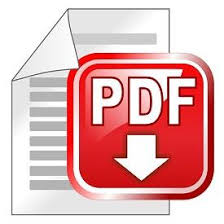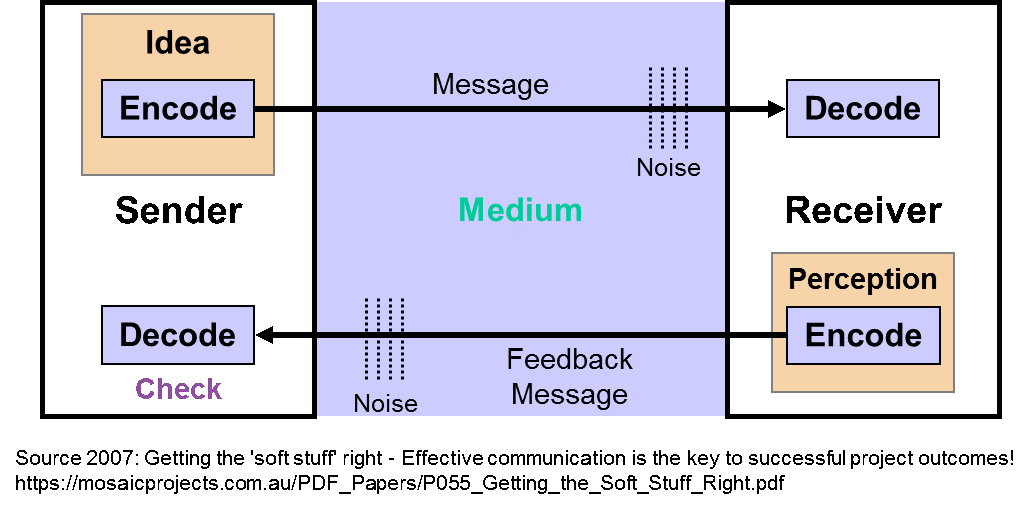Location:
PMKI > PM
Knowledge Areas > Communication
Management.


- Communication Overview
- The Art of
Communication
- Communication
Planning
- Communication Theory and Practice
- Quality in
Communication
- Managing Communication
Artifacts
- Communicating for effect
- Influencing Managers
and Executives
- Influencing Teams
and Meetings
- Engaging
Stakeholders
- Making Controls
Information Effective
- Effective Reporting
- Communication Skills and Techniques
- Useful External Web-links &
Resources.
Other related sections of the PMKI:
- Reporting &
Communicating Controls Information
- Stakeholder Engagement
- Resource Management
(HR & Teams)
- Knowledge
Management
 Communication
management involves managing the information assets of the
project and the organization including all aspects of:
creating, collecting, distributing, storing, retrieving,
and ultimately archive or dispose of project information
in a timely and appropriate manner. As part of this
process, there are frequently legal obligations associated
with privacy, security of information, and the retention
of information that should be considered. The
archiving and storage of many communication assets is
closely aligned with knowledge
management (click through for more on KM). This
subject is focused on making appropriate and necessary
information available to project stakeholders in a timely
manner and responding to other requests for information.
Communication
management involves managing the information assets of the
project and the organization including all aspects of:
creating, collecting, distributing, storing, retrieving,
and ultimately archive or dispose of project information
in a timely and appropriate manner. As part of this
process, there are frequently legal obligations associated
with privacy, security of information, and the retention
of information that should be considered. The
archiving and storage of many communication assets is
closely aligned with knowledge
management (click through for more on KM). This
subject is focused on making appropriate and necessary
information available to project stakeholders in a timely
manner and responding to other requests for information.
Effective communication is a core component of project success; your project will only be considered successful if its key stakeholders perceive the project’s outcome as a success. These perceptions of success or failure are heavily influenced by the effectiveness of the project’s communications, and the relationships with its stakeholder community (see more on stakeholder management), and depending on the stakeholder, information may need to be communicated at the strategic level as well as at the specific task performance level. In the last decade, significant changes in people’s ways of working, and the understanding of acceptable behaviours have forced a re-evaluation of the way project and program managers need to communicate to influence their stakeholders*, particularly when 'advising upwards' or dealing with difficult people.
Communicating effectively requires a clear understanding of the objective of the communication plus the skills needed to create messages that are focused on the right people, at the right time, and carry the right information in the right format. This level of effective communications requires an understanding of:
This section includs papers on the processes, tools, reports and other processes needed to plan, collect, create, distribute, store, and ultimately archive or dispose of project information.
Art: New Ideas hidden in the Fog of Change. Or 'Stop the world, I want to get off'. Complex language may impress some but it prevents effective communication with most stakeholders. Based on an original article from 1981 (read the original article).
* Our Project Management in the time of COVID series looks at some of the aspects that are driving change in communication in a post COVID world.
To communicate properly, you need to deliver the right message to the right audience at the right time.
Step 1: Identify the Strengths, Weaknesses, Opportunities and Threats (SWOT) of the current situation. Lessons learned from past communications help.
Step 2: Determine your communications objectives. Inputs from stakeholder engagement and risk mitigation activities help define the key objectives that you want to achieve from your project communications.
Step 3: Develop the formal communications guidelines for controlling communications within your project. These may be mandated by the organizations for formal communication, but don't forget the power of informal channels as well.
Step 4: Define exactly who your team will formally communicate with. Formal communications include various reports (see more on reporting) and presentations to meetings, the various communications should promote a single, consistent, view of your project to a specified audience so that everyone has the same version of the truth.
Step 5: Next focus on the needs of specific stakeholder and what the project requires from them. These stakeholders will require focused information that is specific to their role in the project, which is designed to manage your relationship with them and obtain the necessary resources or support. The Stakeholder Circle® is one way to focus thinking on the important stakeholders.
Step 6: List the key messages that need to be sent to each Stakeholder and the delivery channel you will use to deliver each message to them. The delivery channel for each stakeholder may be formal, informal direct or indirect, the key is to ensure the message gets through.
Step 7: Plan your communication schedule, defining the activities and actions that are required to deliver the right messages to the right people at the right time throughout the project. Include communication events in the project schedule, specify the time frames for completion and any dependencies on other events in the schedule. Report on communication in the same way as any other project task!
Step 9: Delegate communication activities. Define the purpose of each communication, how it will take place and when it should occur. Then identify who will manage the process and who will review their effectiveness. Monitor the effect of your communication on stakeholders asking 'is it working?' and taking appropriate action to optimize outcomes.
Dr. Lynda Bourne's article for PM World Journal
expands on these basic steps:
Art: Communication planning.
Communication planning is an essential element in crafting
a communication strategy that will work to support the
success of the project.
 Our
Communication
Worksheet is a practical Excel template for
establishing and monitoring the routine reporting and
communication requirements of a project or program - see
more.
Our
Communication
Worksheet is a practical Excel template for
establishing and monitoring the routine reporting and
communication requirements of a project or program - see
more.
Communicating effectively with stakeholders is as much an art as a science. It starts with understanding who the project's stakeholders are, then determining the reason you need to communicate with the person and designing a communication strategy to achieve your desired outcome. Finally, as the communication strategy is implemented, processes need to be in place to measure the effectiveness of the communication and make sure it is working effectively.
Effective communication with key stakeholders is a critical element in achieving a successful project outcome; it is a two way process, and at the very least, for a communication to be complete, the sender needs to know the message has been received and understood. This model is an engineering model, and was developed to explain data communications, it can also be used to help understand personal communication.

WP: Communication Theory. This white paper provides the framework for developing effective communications. To make each communication effective, careful thought has to be given to the choice of media and message, how the message will be delivered (and who will deliver it) and the best writing, or presentation style to use based on the personality of the person you wish to communicate with.
Art: Communicating with Purpose. There is absolutely no point in communicating with someone if you do not want an effect! The effect you are seeking can vary dramatically, but you need to know what it is! For maximum effect, you also have to select between 'push' and 'pull' communication and the type of communication used.
PP:
Getting the 'soft stuff' right - Effective
communication is the key to successful project
outcomes! This paper discusses:
- Techniques to determine the right stakeholders to focus
communication effort on at each stage of
a project
- Influence Mapping
- Elements of Effective Project Communications: right
message, right messenger
- Strategies for communicating effectively
- Complexity Theory from a communications perspective
- Managing and communicating risk and uncertainty, and
- The key role of a PMO as the communicator and translator
between projects and management
(see more on PMOs).
View the PowerPoint presentation.
Crosby’s edict that ‘quality is free’ applies to the implementation of a fit for purpose communication regime. The costs of inadequate communication can be catastrophic:
Art: The Costs of Quality in Communication. Fit for purpose project communications and reports provide each stakeholder with the information they need.
DP: PMI The High Cost of Low Performance - The Essential Role of Communication. (PMI Pulse of the Profession Publication) The essential role of communications in creating project success.
Art: ‘Not knowing’ is no longer an option. Effective governance and management requires timely access to ACCURATE information.
The paper, electronic, and other records of each communication may be of significance to the project or the organization in the future. In many jurisdictions laws place the onus of documenting communication onto the sender, if you cannot provide the information (maybe years in the future) the assumption is the communication contained the information alleged by the other party. Many communications also contain valuable knowledge that can be used by the organization. Processes to keep copies of 'all' communications (other than verbal communications) are relatively simple to implement. The challenge is developing processes to store the mass of data in ways that can be interrogated cost-effectively.
Art: The challenge of 'e-Documents'. Electronic document management offers many advantages over traditional 'paper-based' systems, but also creates challenges. This article discusses some of the factors needed in a effective e-Document system.
Art: Data to Wisdom – Creating and Managing Knowledge. Looks at the processes and documents used to transform raw data into the knowledge needed for wise decisions from a project controls perspective. Click through for more on knowledge management (KM).
 There is no point in
communicating if you don't want an outcome!
There is no point in
communicating if you don't want an outcome!
As George Bernard Shaw once said “The single biggest
problem in communication is the illusion that it has
taken place”. Project professionals routinely
complain about the slow pace of decision making and/or the
lack of sensible decisions from management and clients -
but this is entirely understandable if the decision maker
feels they are being denied the information needed to make
a decision because they do not fully appreciate or
understand the information in the format provided.
Effective communication gets the right information to the
right person, in a format they can understand so they can
use it to make effective decisions. This starts with
understanding who the project's stakeholders are (click
through to see more on stakeholder identification and
prioritization), and their communication
requirements:
These three types of communication require different approaches to achieve the best effect and galvanize support for the project. Art: The three types of stakeholder communication outlines the three types of communication:
Communicating for effect requires an understanding of the stakeholder's interests and the objective of the communication. This allows you to align what is needed from the stakeholder with the stakeholders interests.
Art: Communicating for Effect. There is absolutely no point in communicating with someone if you do not want an effect! But you need to be clear on the effect you wish to achieve.
Art: Have we communicated? “The major problem in communication is the illusion that it has occurred”. This paper looks at some of the language problems in communication.
Blg:
What is your personal brand? If you want a
stakeholder to ‘buy into’ your ideas, believe your
communication or take action on your recommendations they
need to recognize you as a credible messenger, how they
perceive you is framed by your 'personal brand'.
Blg: Integrity is the key to delivering bad news successfully. Integrity is the result of a combination of virtues. You have to earn a reputation for integrity based on what you are, and more importantly what you are known for by the people you have to deliver the bad news to.
Art: NEWSPEAK - is not all that new! A 'left field' look at communication and the use of language to influence thinking based on George Orwell's novel 1984.
Crafting advice to senior management to achieve effective outcomes from the communication is as much an art as a science. But, effective communication with senior management should not be seen as a one-off effort by an individual project manager. Rather it’s an on-going collegiate effort by all project practitioners within the organization; designed to inform, educate and influence senior managers so that ‘sensible’ project decisions become the norm. No senior manager with integrity will commit to a project knowing its objectives cannot be achieved but communicating this information can be difficult!. Most projects that are committed to achieve ‘impossible’ time, cost and/or scope objectives are started because the correct ‘project management’ messages were not received and believed by the senior managers commissioning the project.
A key element in honest communication is knowing what is possible. It's therefore critical that project practitioners clearly explain the limitations of project management processes and use effective risk management to deal with the inherent uncertainty associated with every project forecast; then actively monitor, update, adjust and report progress.
Effectively managing the relationship with senior executives is a core component in achieving project success. The skills needed to be able to provide advice to senior managers that is understood and accepted are outlined in the papers and book below:
PP: Advising upwards:
managing the perceptions and expectations of senior
management stakeholders.  The experiences of the
authors, in large organizations, in managing the
expectations and the support of key senior stakeholders
provides a foundation for exploration of the tasks needed
to turn a Commander into a Sponsor, how to use the
resources available in the form of influence networks,
targeted communication and plain persistence. Results are
not miraculous, small improvements must be celebrated, the
possibility of failure contemplated. Download the full journal paper.
The experiences of the
authors, in large organizations, in managing the
expectations and the support of key senior stakeholders
provides a foundation for exploration of the tasks needed
to turn a Commander into a Sponsor, how to use the
resources available in the form of influence networks,
targeted communication and plain persistence. Results are
not miraculous, small improvements must be celebrated, the
possibility of failure contemplated. Download the full journal paper.
 Advising
Upwards: A Framework for Understanding and
Engaging Senior Management Stakeholders. Dr.
Lynda Bourne: This book focuses on building, and
managing the relationships with senior (upwards)
stakeholders that are essential for success. This requires
the activity manager to be skillful at building and
maintaining robust relationships, focused on engaging the
support of senior executives, understanding their
expectations and managing them through targeted
communication. See
more.
Advising
Upwards: A Framework for Understanding and
Engaging Senior Management Stakeholders. Dr.
Lynda Bourne: This book focuses on building, and
managing the relationships with senior (upwards)
stakeholders that are essential for success. This requires
the activity manager to be skillful at building and
maintaining robust relationships, focused on engaging the
support of senior executives, understanding their
expectations and managing them through targeted
communication. See
more.
Art: Communicating Upwards for Effect. The key to effective communication is clarity created through simplicity. But frequently people use the same words in similar context but apply completely different meanings. We say something; they attribute their different meaning and know they have understood exactly what we’ve said – but their understanding is not what we meant!
Art: Influence without authority. How to build credibility and acquire the ‘currency’ you need to trade for the support and help you require.
Blg: Advising Upwards for Effect. The project team need to be able to effectively ‘advise upwards’ so their executive managers understand the potential value that can be generated from the project and work to ensure the organization makes effective use of the project’s deliverables.
PP: Achieving a Successful Engagement. (managing key stakeholder's expectations) Projects will only be considered successful when their key stakeholders acknowledge they are a success. This requires the project team to effectively engage with each of its key stakeholders to understand and manage their expectations and then deliver to project to meet or exceed the ‘managed expectations’. This paper is based on the widely used Stakeholder Circle methodology, and defines a structured but flexible approach to identifying and engaging a project’s stakeholders throughout the lifecycle of the project. The methodology describes ways to identify and prioritize stakeholders, understand their needs and expectations, develop targeted communication strategies to influence attitudes and behaviour, and then to measure the effectiveness of the overall strategy in maintaining the support of key positive stakeholders and reducing opposition from negative stakeholders.
See more on meetings in our team management topic.
WP: Managing Meetings. To make meetings effective, careful thought has to be given to the choice agenda, the attendees, and the specific purpose of each meeting. Meetings are an important communication forum.
Art: How to influence others. Ways to use the meeting environment, questions and body language to positively influence others.
Effective communication is the tool that facilitates the
building of relationships and engagement with
stakeholders, but to be effective this type of
communication needs to be focused, personal and two-way.
As a consequence, the project team need to invest
significant time and effort in these key communication
channels. The challenge is identifying the right
stakeholders to invest effort in, and the right messages
to communicate ‘at this point in time’. This requires:
- Identifying the important stakeholders ‘at this
point in time’
- Understanding their needs and objectives as well
as what you need from them (mutuality)
- Assessing their current attitude as well as the
desired attitude for optimum success
- Developing a communication strategy to achieve the
appropriate levels of relationship, engagement
and support from both the key stakeholders,
and other stakeholders. Including selecting the best
messages, messenger and medium
- Effectively communicating with the rest of the
stakeholder community using a combination of ‘push’
and ‘pull’ processes
- Periodically review and revise the communication
strategy for optimum outcomes.
Art:
The three types of stakeholder communication.
There are three general classes of communication that are
needed in an effective stakeholder management:
- Traditional reporting
- Project relations (PR - marketing), and
- Directed communication focused on achieving an effect.
This paper explains how they work together for effective
stakeholder communication.
A more expansive discussion on engaging stakeholders to make projects successful is contained in our book:
 Making
Projects Work: Effective Stakeholder and
Communication Management. Dr.
Lynda Bourne: The premise in this book is projects
are performed by people for people, with the key
determinants of success being the relationships between
project teams and project stakeholders. This matrix of
relationships will either enable or obstruct the flow of
information between people and, as a consequence, will
largely determine project success or failure. See
more.
Making
Projects Work: Effective Stakeholder and
Communication Management. Dr.
Lynda Bourne: The premise in this book is projects
are performed by people for people, with the key
determinants of success being the relationships between
project teams and project stakeholders. This matrix of
relationships will either enable or obstruct the flow of
information between people and, as a consequence, will
largely determine project success or failure. See
more.
Blg: Effective Communication = Effective Project Stakeholder Management.The project’s stakeholder engagement and communication planning needs to develop an overall strategy for these two closely linked processes and then identify appropriate tactics to maximize the probability of achieving a successful project outcome.
Art: Targeted communication - The key to effective stakeholder engagement. Designing a 'directed communication' strategy for your project.
PP: Targeted communication - the key to effective stakeholder engagement. Just as each project is unique, so are its stakeholders! Whether as individuals, groups or organizations, every stakeholder, and every stakeholder community has a unique and evolving set of cultures, expectations and perceptions. To engage with, and influence, these diverse communities, the traditional approach to project communications of regular reports and other ‘one size fits all’ strategies needs to be replaced. Effective communication takes into account the complexity of the people who work with, or benefit from, the outcomes of the project; and works to engage the constantly changing group of people whose support and involvement are essential to project success – this requires communication competence.
 Simply
sending a mass of complex project controls data to a
manager or team member is not communication. Communication
requires the transmission of information in a form that is
understandable and relevant to the recipient. Only when
the information has been received and understood can it be
used by the recipient to influence their decisions about
future actions. Far too many controls professionals make
the mistake of assuming everyone has the same appreciation
of ‘simple’ reports generated from various controls tools.
The problem with this assumption is the simple fact you
have no idea what is actually being understood by the
stakeholder unless you take the trouble to test the
assumption.
Simply
sending a mass of complex project controls data to a
manager or team member is not communication. Communication
requires the transmission of information in a form that is
understandable and relevant to the recipient. Only when
the information has been received and understood can it be
used by the recipient to influence their decisions about
future actions. Far too many controls professionals make
the mistake of assuming everyone has the same appreciation
of ‘simple’ reports generated from various controls tools.
The problem with this assumption is the simple fact you
have no idea what is actually being understood by the
stakeholder unless you take the trouble to test the
assumption.
Art: Stakeholders and Complexity. Project ‘control systems’ don’t control anything and to a large extent, neither can project managers. In the complex world of the 21st century, communicating to influence outcomes is the key to success.
Art: Stakeholder’s Don’t Understand Numbers! Project controls processes and project reports are full of numbers and calculations and one would think that most project stakeholders, particularly senior managers, would see and understand the numbers in the same way. Unfortunately resent research suggests this is not the case.
PP: Understanding Design - The challenge of informed consent. The need to communicate effectively is a vital component of leadership. You cannot lead people if they don’t understand you. Informed consent from committed followers is more enduring, and people are likely to support any efforts to work through to a solution to the problem. Which raises the question 'How much of a design do engineering clients really understand?'. A simple design document for one group of design professionals can be virtually impenetrable to other professionals, and more importantly their clients. The need to communicate effectively is vital when an engineer wants to lead a group of ‘others’ in developing a design solution, but you cannot lead people if they don’t understand you. ‘Blind trust’ may work if the solution is straightforward, but when problems arise, uninformed trust evaporates; informed consent from committed followers is more enduring. This paper uses the evolution of the design of the Sydney Opera House roof as a case study to highlight the different perspectives on design information, starting with the free-form curves envisaged by Jørn Utzon to the mathematical (and buildable) curves developed by Ove Arup as segments of a sphere (such as an orange). The metaphor of the segments of ‘orange peel’ that helped make the curves possible was also used to explain the concept of the sails to the public and politicians. With the advent of integrated design and Building Information Modelling (BIM) on one side, and the emergence of social networking and ‘instant protest movements’ on the other, the importance of communicating complex design information to the clients and wider public will become an increasingly important component of a successful engineering project. This paper suggests that the effective use of similes and metaphors to help people understand what is really involved in a project can convert uninformed protesters (frightened by what they don’t understand) into informed supporters. This applies to ‘client committees’ as well as to the wider public.
Prs: Understanding the Schedule - The Challenge of Informed Consent. This presentation adapts the main paper (above) to look at the challenges associated with communicating controls information in a way that is understood and appreciated by stakeholders (particularly senior managers) so they can use the information to make informed decisions.
Prs: Communication in organisations: making the schedule effective. There is no point working hard to develop a schedule that is not used! One of the major challenges facing project teams and PMOs is effectively communicating the technical data created as a result of developing or updating a schedule (and other project specific information). This presentation looks at the schedule from the perspective of its role as a communication medium that can have a powerful influence on the successful delivery of a project, provided the information contained in the schedule is understood and used. With effective communication, the schedule can encourage the engagement of stakeholders, assist in minimizing risks and highlight issues.
PP: Controls Communicate? Data in a control tool is useless until it is communicated in the right way to the right people to help manage the project. This paper explores how communication in the form of information exchange controls and assists the work of organization to create value and drive performance; and the effect caused by the way these control systems are developed to assure management that the work is progressing as planned. It will take a critical look at what can, and what cannot be achieved by project control systems (people, tools and outputs) in the effective management of projects from a communication, motivation and stakeholder management perspective, and explore how communication in the form of information exchange controls and assists the work of organizations to deliver value to all stakeholders.
You cannot avoid reports; they are required by your
company and often by law. You simply create them as
needed. Some examples include:
• Project Status Reports
• Minutes of meetings with your sponsor or project
steering committee
• Required reports to shareholders or your Board of
Directors
• Government mandated reports, safety reports, HAZOP,
audit reports, etc.
Reporting may not be communication but it is useful. The information in reports is typically pushed (ie, sent directly to) to recipients and whilst this creates a consistent set of data in a time series of themselves reports are not communication, although information in a report can be used as part of a purposeful communication.
Art: Reporting is not Communicating. Reporting and communicating are not the same! Simply sending out information in a large complex document has very little to do with effective communication.
PP: Beyond Reporting - The Communication Strategy. Reporting and communicating are not the same! Every project, program and PMO manager produces reports on a monthly, weekly and sometimes daily basis but these reports are not necessarily communication. Effective communication with key stakeholders required sending messages that are received, understood and where appropriate, acted upon by the stakeholder. This paper provides a framework for managers to use to plan, design, implement and measure the effectiveness of their communication strategies with key stakeholders to help achieve successful outcomes for their projects and programs. Simply producing reports is not enough, at the very least, for a communication to be complete, the sender needs to know the message has been received and understood.
Art: Are Traditional Reports past their use-by date? The challenges of replacing traditional reports with real-time dashboards are significant; this article looks at the challenges.
Art: Project Reports and the PMBOK. The PMBOK® Guide 5th Edition included a significant refinement in the way project data is transformed into useful project reports. The flow from raw data to useful reports (processed information) is fairly well defined; these concepts are refined and expanded in the 6th Edition.
 Our
Communication
Worksheet is a practical Excel template for
establishing and monitoring the routine reporting and
communication requirements of a project or program - see
more.
Our
Communication
Worksheet is a practical Excel template for
establishing and monitoring the routine reporting and
communication requirements of a project or program - see
more.
 Communication
is the only way to influence and direct the work, or
behaviour, of others, therefore, project manager should
spend 80% to 90% of his/her time communicating. This
sub-section looks at some of the communication skills
needed by successful project managers.
Communication
is the only way to influence and direct the work, or
behaviour, of others, therefore, project manager should
spend 80% to 90% of his/her time communicating. This
sub-section looks at some of the communication skills
needed by successful project managers.
WP: Active Listening and Effective Questions. Listening is a conscious activity which requires attention. The right types of question support effective listening and can influence conversations and decisions. These two skills in combination are very powerful.
Art: Ask for information you can use. If you are not careful, the easy to measure drives out the harder to quantify, even when the latter is more important.
WP: Effective Explanations. Explanation is a key communication skill for making ideas, products, and services easier to understand.
Art: The Origins of Standard Gauge Railways - Myths and Legends . Storytelling is an important aspect of effective communication. However, as this article demonstrates, it is important to get the story right!
WP: Writing Documentation. Effective writing is a key communication medium for all aspects of project management. This paper outlines several universal rules for effective business writing.
WP: Page Layout & Design. The concept of layout design is separate from content design. Good document design will not overcome badly written content; but a poorly designed document will significantly reduce your reader’s comprehension of the message you are trying to convey.
WP: Presentation Skills. Public speaking is one of the hardest things to master. This paper covers the preparation and presentation of information in a public forum including creating and using effective PowerPoint slides.
Blg: The role of Oration in Communication – a lost art? You need to apply a completely different set of skills and re-structure the information in a well written document if you want to communicate the same message verbally, this is the art of ‘oration’.
Art: Rhetoric can backfire. The art of effective persuasion and explanation is to enliven a well constructed argument by the appropriate use of rhetoric to engage with your audience and help them understand and agree with the position you are putting. However, if you base your whole position on the clever use of rhetorical constructs expect the backfire as soon as someone finds the weak point in your position and ‘pulls the pin’.
Art: What’s the message?? How data is presented can change the message. The way schedule reports are designed will change the understanding of key stakeholders (also see Making Controls Information Effective above).
Blg: Mind your language. A picture may tell a 1000 words, but it needs to be a well designed picture if the message is to be meaningful.
Art: Is what you heard what I meant? Effective communication between project stakeholders is always difficult and misunderstanding and confusion are easily created if information is not structured sensibly.
Art: Communicating in Conflict. One of the realities of life is every once in a while, you are going to become embroiled in a dispute or argument that is emotional and personal. This article maps out a set of strategies that can help you stay focused on using communication to achieve a pragmatic outcome you can 'live with'.
Negotiation is a special form of communication -
this is covered in our
procurement page
(but applies widely)
 Stakeholder
Management: https://www.stakeholdermapping.com/
Stakeholder
Management: https://www.stakeholdermapping.com/